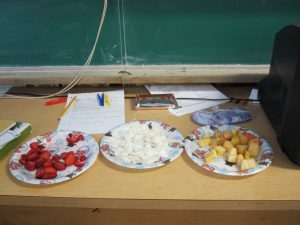This post is especially for new teachers who are feeding children regularly. You probably aren’t working for a wealthy district. The kids in wealthy and middle-class districts often carry snacks in their backpacks, while kids in poor districts may not have that handy Tupperware container of apple slices or pretzels, or the ubiquitous bag of Takis.* You are probably making less money, maybe much less money, than teachers in those more financially-comfortable districts. One of the ironies of teaching I have observed: Those who make the least frequently spend the most for their classroom, or at least a greater percentage of their incomes, since poor districts often provide little or no money for classroom supplies.
I suggest teachers who are passing out pretzels join Costco or Sam’s Club. My membership always paid for itself easily, especially since I bought Costco gas and made full use of my benefits. Vacation rental cars alone have saved me hundreds of dollars over the last few years.
Those big containers of pretzels, baked chips, cereal and Harvest Snaps® have carried many students through a tough morning when they missed breakfast and had no food in the house. The jars of Twizzlers®,** jelly beans, Jolly Ranchers®, Skittles® and more make good Jeopardy or Kahoot rewards in schools that allow candy. In classrooms that allow nuts, the big jars of nuts always get a grateful response. Kids love this healthy snack and most years I was lucky enough to be able to bring in nuts as a special treat, lacking allergic kids and a school-wide rule.
Eduhonesty: Taking a short break this morning from the mega-issues.
*I hate Takis. Those flaming red chunks can’t be good for anybody. Can something this color be food? Maybe I am getting old. 
**Yes, I will sign off on candy rewards. While I acknowledge the nutritional concerns, I also know that the intervention period where I gave out Jolly Ranchers® for improved typing speeds led to the most dedicated typing practice I had ever seen. Does that reward burn out eventually, losing its effectiveness? Yes, but for some kids, I never reached that burn-out point all semester. Most importantly, a kid who starts at 7 words per minute and “burns out” at 35 words per minute has reached lift-off. The foundation has been laid at 35 words per minute and practice alone should carry the rocket up from there.
In a time of many macroconcerns, I went micro with this post, but my ** paragraph above brings up a huge issue. Teachers are told constantly what supposedly works and what doesn’t work. Sometimes that information should not be trusted. Big, blanket rules often do not fit smaller situations. For example, the candy burn-out concern has solid data behind it. Reward, reward, reward and the rewards lose their impact. But for a short-term goal like launching typing skills, rewards can work wonderfully. For any skill that can be achieved quickly, rewards may be helpful. The achievement of the skill allows for a natural end to the reward, too.

